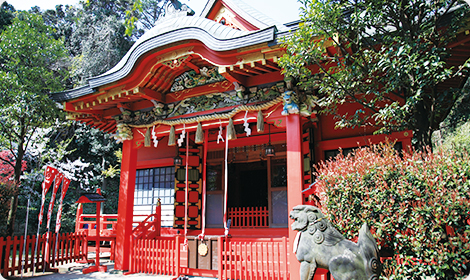Enoshima Shrine

Bronze Torii Gate
This bronze torii gate is located just over Enoshima Bentenbashi Bridge. Originally made of wood, the gate was rebuilt in bronze in 1821, and the names of the financial donors who helped pay for it are carved on the gate. The gate is a designated cultural property of Fujisawa City.

Enoshima Shrine Gatehouse
This gatehouse is named Zuishinmon, and is modelled on the mythical Ryugu-jo (castle under the sea depicted in the Japanese tale "Urashima Taro"). Zuishinmon can be taken to mean "pure soul", and it was named as such in the hope that visitors could refresh their minds by praying here.

Enoshima Shrine was first built at Iwaya in 552 upon the imperial order of Emperor Kinmei. Today, three shrines called Hetsunomiya, Nakatsunomiya, and Okutsunomiya, are collectively known as Enoshima Shrine, a name which it has held since the Shinto-Buddhism syncretism during the Meiji Period.
Who is Benzaiten?
Together with the shrines on Miyajima (Hiroshima Prefecture), and Chikubushima (Shiga Prefecture), Enoshima is known as one the three most famous shrines to Benzaiten in Japan. Benzaiten was originally an Indian God of Water, and it is believed that the Benzaiten faith in Japan began during the Nara Period.
Together with the shrines on Miyajima (Hiroshima Prefecture), and Chikubushima (Shiga Prefecture), Enoshima is known as one the three most famous shrines to Benzaiten in Japan. Benzaiten was originally an Indian God of Water, and it is believed that the Benzaiten faith in Japan began during the Nara Period.
Hoanden (Octagonal Hall of Statues)

Situated next to Hetsunomiya Shrine, Hoanden is modelled on the Yumedono (Hall of Dreams) of Horyu-ji Temple in Nara. It is said that Minamoto no Yoritomo donated the statue of Happi-Benzaiten in 1182, with the statue of Myoon-Benzaiten (Hadaka, or Naked Benzaiten) being donated later during the Edo Period.
Note: The renovations that were taking place were completed on October 24th.
Information
Admission Times: 8:30 to 16:30
Admission Fee:
Adults ¥200
13-18 yrs ¥100
Under 13 yrs ¥50
Admission Times: 8:30 to 16:30
Admission Fee:
Adults ¥200
13-18 yrs ¥100
Under 13 yrs ¥50
Nakatsunomiya

Okutsunomiya

Enoshima Sightseeing "What to See"
Enoshima Benzaiten Nakamise Street
Enoshima Samuel Cocking Garden and Enoshima Sea Candle
Ryuren no Kane (The Bell of the Dragon's Love)
Enoshima Iwaya cave, Benten Maru

